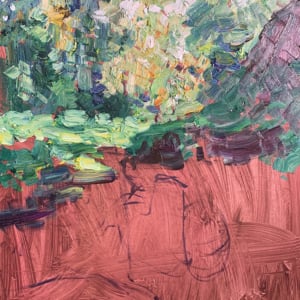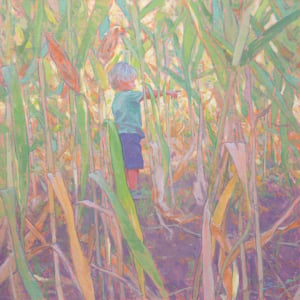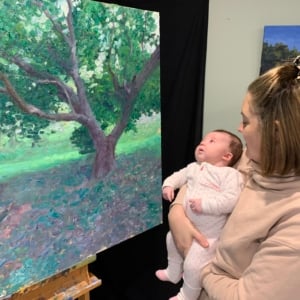Emphasis is a principle of art that refers to the use of visual elements to draw attention to a certain area, usually a focal point, in an artwork.
There are many ways you could go about using emphasis in your art. Usually, it involves contrasting different elements against each other. For example, a bright, red object will stand out amongst a dull gray background. Or a straight line amongst curved lines. Or a round object amongst circular objects. In this post, I cover:
- What Should You Emphasize?
- Master Painting Examples of Emphasis in Art
- Want to Learn More?
- Thanks for Reading!

What Should You Emphasize?
Before you try to use emphasis in your art, you need to ask yourself what am I going to emphasize? It would be counter-productive to draw attention to unimportant areas in your painting.
Consider what your focal point is and what you are trying to communicate through your painting. What is your big idea?
Take the painting below by John Singer Sargent for example. The focus of the painting is clearly the Parisian beggar girl. Notice how Sargent used emphasis for the girl’s extended hand; hard edges and that burst of red around her forearm draw your attention towards this area. Her face, on the other hand, is left vague and ambiguous. This works in favor of Sargent’s big idea for the painting-her begging hand is more important than her identity.


Master Painting Examples of Emphasis in Art
Below are some more examples of emphasis in art, starting with Impression, Sunrise by Claude Monet. Your attention is drawn towards the vivid orange sunset, which stands out from the weak blues, greens, and grays in the background. Monet used color saturation in this case to emphasize the sunset.

In the painting below, Giovanni Boldini used thick paint and saturated color to emphasize the flowers in the vase. Notice how the background is nothing but a thin stain of color.

In Research by Joaquín Sorolla, the area on the table is emphasized by several elements:
- The light which is illuminating the desk and research area;
- The implied lines created by the men looking down at the table (we want to look where they are looking);
- The relatively bright colors used for whatever is in the bottles; and
- The lightest light, being the white shirt of the researcher sitting down.

In Valentin Serov’s painting below, the woman looking out over the ocean breaks up the tapered line created by the crashing shore. This interruption of the line makes a powerful statement and emphasizes the position of the woman.

In George Inness’ moody tonalist painting, the sunset over the sea is emphasized by the increased color saturation and the warm colors.

Light is obviously the main source of emphasis in the painting below, with most of the painting being in shadow and just a few areas being illuminated by the lamp.

In Monet’s high-key landscape, Poppies, the foreground is emphasized by the presence of the figures and the relatively vibrant red poppies, which stand out against the surrounding greens and blues.

In Berthe Morisot’s painting below, the two figures are emphasized by their strong position in the painting around the center. There is also a stark contrast between the deep black of the woman and the white dress of the child.

Want to Learn More?
You might be interested in my Painting Academy course. I’ll walk you through the time-tested fundamentals of painting. It’s perfect for absolute beginner to intermediate painters.
Thanks for Reading!
I appreciate you taking the time to read this post and I hope you found it helpful. Feel free to share it with friends.
Happy painting!
Dan Scott

Draw Paint Academy







We are not doing something during those classes.🇨🇨
Does it likely for the first time since it is a long term overall.🤮
We are proud our classes do home-works and drawings!🍴
Great article sir,
It’s very informative and helpful.
I also write articles related to Art field, Checkout artpalaver.com If you want read more art related content.
Wow this search engine is so helpful, tbh this is the only way I can find information for school.
It very difficult to get the best way for me
.